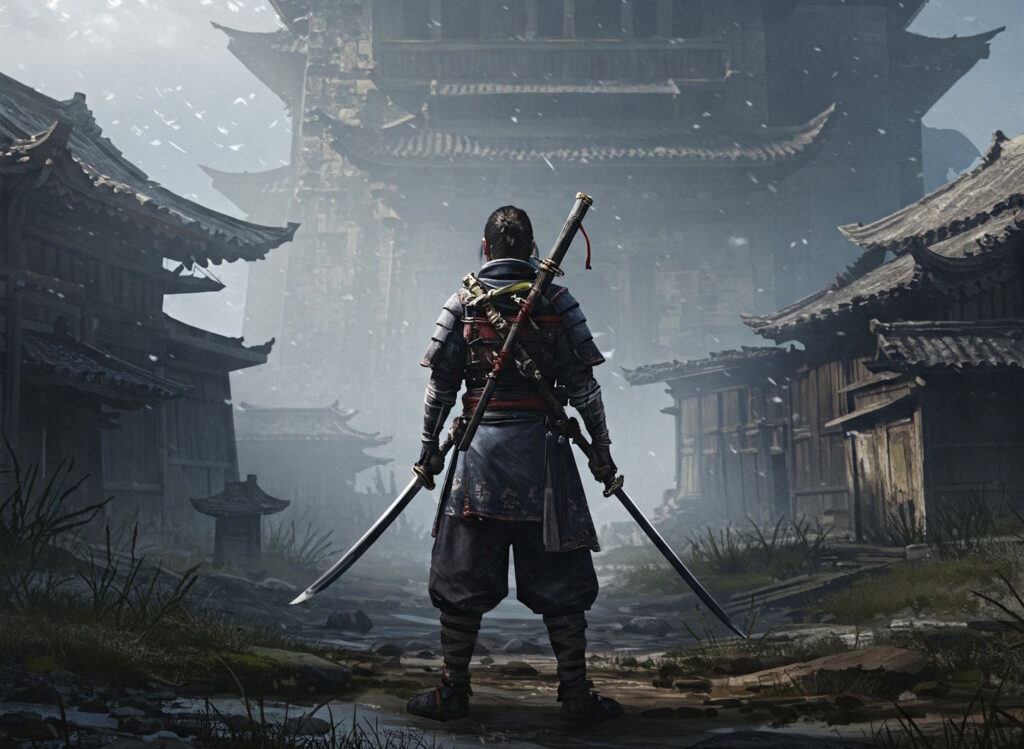Introduction to Ghost of Tsushima
Ghost of Tsushima is an acclaimed action-adventure game developed by Sucker Punch Productions and published by Sony Interactive Entertainment. Set in the late 13th century, during the Mongol invasion of Japan, the game follows the story of Jin Sakai, a samurai warrior who becomes one of the last defenders of Tsushima Island. As the invasion devastates his homeland, Jin faces a moral dilemma: to uphold the samurai code or to adopt unconventional guerrilla tactics to fight against the invaders. This internal conflict drives the narrative, providing an intricate blend of heroism, sacrifice, and the struggle for identity amidst chaos.
The feudal Japanese setting is not only a backdrop but also a character in itself, enriched with stunning landscapes, vibrant towns, and historical significance. Players navigate through vast open worlds, featuring fields of golden grass, snow-capped mountains, and serene temples. The attention to detail in the environment enhances immersion, allowing players to experience the rich cultural elements of 13th century Japan. Ghost of Tsushima uniquely combines historical storytelling with beautifully crafted gameplay mechanics, presenting an emotionally engaging experience.
Upon its release on the PlayStation 4 in July 2020, Ghost of Tsushima received widespread critical acclaim, praised for its sweeping visuals, engaging combat system, and evocative sound design. Reviewers lauded the game for its open-world exploration and the balance of cinematic storytelling with player agency. The exploration of themes such as honor and resilience resonated deeply with players. As interest grows in its upcoming PC port, expectations are high concerning how the game will translate into different hardware. Gamers are intrigued to see if the stunning visuals and engaging gameplay elements will be even more enhanced on modern PC systems, continuing the legacy of this remarkable title.
The Transition from Console to PC
The shift from console to PC gaming often presents a mixture of challenges and advantages. One key aspect of this transition is the optimization of graphics. Consoles, like the PlayStation 4 and PlayStation 5, are fixed configurations with dedicated hardware, allowing developers to easily tailor their games to run efficiently. In contrast, the PC ecosystem comprises a diverse range of hardware, necessitating a more complex approach to performance optimization. Game developers must account for various graphics cards, processors, and memory configurations, which can lead to inconsistencies in gameplay experience across different systems.
One of the benefits of moving a title like Ghost of Tsushima to PC is the potential for enhanced graphics. PCs typically outpace consoles in terms of raw processing power, enabling higher resolutions, better texture quality, and advanced graphical features such as ray tracing. As players demand richer visuals, developers can utilize the capabilities of modern PCs to elevate the in-game experience significantly. Furthermore, dedicated players often invest in high-refresh-rate monitors and graphics hardware, allowing for smoother gameplay that is particularly crucial in fast-paced action sequences.
Additionally, the transition to PC allows for the inclusion of features that were either impractical or unsupported on consoles. For instance, modding support can breathe new life into a game by introducing user-generated content, which enhances replayability and customizability. Additionally, the flexibility of controls on PC, including mouse and keyboard or customizable gamepads, provides players with options that cater to their personal preferences. Overall, while the transition from console to PC may involve challenges regarding compatibility and optimization, it also paves the way for a richer and more tailored gaming experience.
System Requirements for Ghost of Tsushima on PC
To ensure an optimized gaming experience for Ghost of Tsushima on PC, players must meet certain hardware specifications. These requirements are categorized into minimum and recommended specifications, which assist players in determining whether their current setups can support the game. The minimum system requirements represent the baseline needed to run the game, albeit with reduced graphical settings, while the recommended requirements provide a guideline for achieving an enhanced experience with better visuals and performance.
The minimum system requirements for Ghost of Tsushima on PC include an Intel Core i5-2500K or AMD Ryzen 5 1400 processor, paired with 8 GB of RAM. Additionally, players should have an NVIDIA GeForce GTX 960 or AMD Radeon R9 280 graphics card, along with at least 50 GB of available storage space. These specifications allow the game to run, albeit not at its optimal quality, and will likely result in lower frame rates and resolution.
For a more immersive experience, the recommended system requirements advise an Intel Core i7-4770K or AMD Ryzen 7 1800X processor. Alongside 16 GB of RAM, players should have an NVIDIA GeForce GTX 1070 or AMD Radeon RX 580 graphics card to fully utilize the game’s graphical capabilities. Sufficient storage space remains essential, and players should allocate at least 50 GB for installation. Meeting these specifications not only enhances visual fidelity but also contributes to smoother gameplay and higher frame rates.
Overall, assessing your system against these requirements is crucial prior to purchasing and running Ghost of Tsushima on PC. Ensuring compatibility can significantly enhance your gaming experience, allowing you to enjoy the stunning landscapes and dynamic action this title offers.
Performance Metrics and Benchmarks
The performance of Ghost of Tsushima on PC has been a subject of considerable interest, particularly among gamers eager to understand how this title performs across varying hardware configurations. Evaluating frame rate benchmarks, resolution capabilities, and load times can provide valuable insights into the gameplay experience across different setups.
In terms of frame rate, the game performs exceptionally well on high-end systems. For instance, a configuration equipped with an NVIDIA GeForce RTX 3080 and an Intel Core i7-10700K reported an impressive frame rate averaging around 120 FPS at 1440p resolution with ultra settings. This performance showcases the game’s optimization for high-performance hardware, allowing players to enjoy smoother gameplay and enhanced visuals.
On mid-range hardware, such as those utilizing an AMD Radeon RX 5700 XT paired with a Ryzen 5 3600, performance metrics indicate a decent frame rate of approximately 75 FPS at 1080p with high settings. Although the performance is slightly lower than that of top-tier setups, it still provides a pleasurable gaming experience without significant compromises in graphical fidelity.
Furthermore, load times are critical for modern gaming experiences. Testing revealed that load times on SSDs averaged around 15 seconds, significantly reducing the downtime between gameplay sessions. With traditional HDDs, however, load times increased to approximately 30 seconds, emphasizing the importance of utilizing SSDs for optimal performance.
Resolution comparisons also reinforce the adaptability of Ghost of Tsushima across various displays. The game supports 4K resolution, allowing players with the appropriate hardware to enjoy stunning visuals. Benchmarking at this resolution on an RTX 3090 yielded frame rates of around 60 FPS, showing that the game maintains a playable experience even at the highest settings. Overall, these performance metrics indicate that Ghost of Tsushima runs remarkably well on PC, accommodating a broad spectrum of hardware configurations while delivering an engaging and visually appealing gaming experience.
Visual Enhancements and Graphics Settings
The PC version of Ghost of Tsushima offers a comprehensive array of visual enhancements and customizable graphics settings, allowing players to tailor their gaming experience to their specific preferences and hardware capabilities. One of the key aspects of these settings is texture quality, which significantly influences the game’s aesthetic appeal. By choosing higher texture quality, players can enjoy more detailed character models and environments, enhancing the overall immersion in Tsushima’s breathtaking landscapes.
Another critical component of the graphics settings is shadow quality. This affects how shadows are rendered in the game, contributing to the depth and realism of the visual effects. Higher shadow quality can create more natural and dynamic lighting scenarios, elevating the graphical fidelity. However, it is essential to balance the shadow settings with overall performance, as high-quality shadows can demand substantial processing power and may lead to a decrease in frame rates if the hardware is not sufficiently robust.
Anti-aliasing is another crucial setting that plays a significant role in visual clarity. This feature minimizes the jagged edges that can appear on objects, providing a smoother and more polished look. Players can choose different levels of anti-aliasing depending on their system capabilities, with options ranging from standard post-process anti-aliasing to more advanced techniques that maintain visual integrity without compromising performance.
Additionally, the PC version supports a variety of resolution options, from standard 1080p to higher 4K resolutions, further enhancing the visual experience for players with more powerful hardware. Ultimately, the balanced integration of these various graphics settings allows players to optimize their gameplay performance while appreciating the stunning visuals intrinsic to Ghost of Tsushima.
User Experience and Gameplay Mechanics
Ghost of Tsushima has garnered critical acclaim for its immersive gameplay mechanics and stunning visuals, which provides an engaging experience on its original platform. With the anticipated port to PC, players are keen to understand how these elements adapt to a new environment. The transition to PC offers an opportunity for players to utilize superior hardware capabilities that enhance graphics and performance, enabling smoother frame rates and higher resolutions.
One of the key adjustments in the PC port is in the control scheme. Players can now opt for mouse and keyboard configurations, which allow for greater precision in combat and movement. The game’s controls have been thoughtfully re-mapped to suit this setup, ensuring that actions remain intuitive. Additionally, support for customizable key bindings means players can tailor their controls to their personal preference, which is particularly beneficial for players coming from different gaming backgrounds.
The user interface has also seen enhancements to facilitate the switch from console to PC. The menus are designed to be more responsive, taking advantage of higher resolutions and broader aspect ratios that PC gaming offers. Information display elements such as health indicators, mini-maps, and objective markers have been optimized for clearer visibility, making gameplay smoother and more enjoyable. Moreover, the port makes it easier for players to access settings and perform adjustments without disrupting the flow of the game.
In conclusion, the Ghost of Tsushima PC port innovatively adapts its user experience and gameplay mechanics for a refined gaming experience. As players navigate the beautifully rendered landscapes of Tsushima, these enhancements ensure that the core intensity of the game’s combat and exploration is maintained while providing the added benefits of individual customization and improved controls.
Compatibility with Various Hardware Setups
As the gaming community anticipates the PC port of Ghost of Tsushima, it becomes essential to evaluate its compatibility with a range of hardware setups. Players with differing specifications can expect varying levels of performance, and understanding these nuances can significantly enhance the gaming experience. We will explore how this title fares on low-end, mid-range, and high-end PC configurations.
For low-end setups, even though Ghost of Tsushima is a visually rich game, it has been optimized to run adequately on less powerful hardware. Players equipped with integrated graphics or older dedicated GPUs may have to lower their visual settings substantially to achieve playable frame rates. Resolutions might need to be dropped, and features such as shadows and reflections may require disabling. However, with careful adjustments, players can still experience the game’s rich storytelling and captivating environment without encountering excessive stuttering or lag.
Mid-range PCs represent the sweet spot where Ghost of Tsushima can truly shine. Those equipped with modern quad-core processors and mid-tier graphics cards can expect a good balance between performance and visuals. In this setup, gamers can comfortably engage with high settings without sacrificing frame rates significantly. It is advisable to tweak specific areas such as anti-aliasing and texture quality to ensure smooth gameplay. This category of hardware enables gamers to appreciate the game’s stunning landscapes and intricate character designs without compromising on frame consistency.
High-end PCs will deliver the most exceptional performance, allowing players to enjoy Ghost of Tsushima in its full glory. With powerful GPUs and ample RAM, users can explore the game’s expansive world at ultra settings with high resolutions and frame rates well above 60 FPS. This setup not only ensures a visually immersive experience but also enhances gameplay fluidity, making combat and exploration even more enjoyable. Players with this configuration should also consider utilizing advanced features like ray tracing if supported by their hardware.
Community Reactions and Reviews
The release of Ghost of Tsushima’s PC port has elicited a variety of responses from the gaming community, ranging from enthusiastic praise to constructive criticism. At its launch, players were quick to share their experiences, often highlighting the visual enhancements that the PC version offers. Many users commended the game’s stunning graphics, noting that the transition from console to PC has taken the already visually captivating world of Tsushima to new heights. The addition of higher resolutions and frame rates was particularly lauded, with players expressing satisfaction with the overall performance upgrade.
However, community feedback has not been entirely positive. Some players reported performance issues, such as stuttering and frame drops, particularly on lower-end hardware. Reviews noted that while the game benefited from enhanced graphics settings, those not equipped with high-end systems might face challenges. A number of users took to forums to discuss optimization concerns, indicating a desire for patches to address these performance related problems. The developers have been responsive, promising updates and adjustments based on player feedback.
Another prevalent sentiment among the community is the desire for additional features and options that were not included in the initial release. Some players expressed disappointment at the absence of certain customization options that they had hoped to see, such as a more extensive control scheme or additional graphical settings. This sentiment was mirrored in several critical reviews, which suggested that while the port of Ghost of Tsushima is commendable, there is significant room for improvement. Overall, the community reactions reflect a blend of admiration for the game’s artistry and a critical eye for its technical performance, leading to a balanced, albeit mixed, perception of the PC port.
Conclusion and Final Thoughts
Ghost of Tsushima’s transition to the PC platform has indeed provided an opportunity for a wider audience to experience its richly woven narrative and stunning visuals. Overall, the performance of the game on PC largely depends on the specifications of the user’s hardware. For those equipped with high-end systems, the game not only runs smoothly but also offers enhanced graphical fidelity that elevates the gameplay experience. The addition of graphic settings and customizable options allows players to tailor gameplay according to their personal preferences and hardware capabilities.
However, the port is not without its drawbacks. Some players have reported occasional performance dips, which can be disconcerting during critical moments of gameplay. Furthermore, while the loading times are generally reduced compared to the console version, they can still be noticeably longer, particularly for those accustomed to modern PC game optimizations. Nonetheless, the availability of mods and the potential for future updates may alleviate some of these concerns over time.
In weighing the pros and cons, it becomes evident that Ghost of Tsushima on PC retains the charm and immersion of its original release, while also adjusting well to the strengths of the platform. The engaging combat, intriguing storyline, and breathtaking landscapes are all enhanced by the PC’s capabilities, making the experience truly remarkable for gamers. Ultimately, for enthusiasts of action-adventure titles and fans of the original PlayStation version, this PC port presents a compelling case for play. It is certainly worth considering for those looking to dive into the world of feudal Japan.



